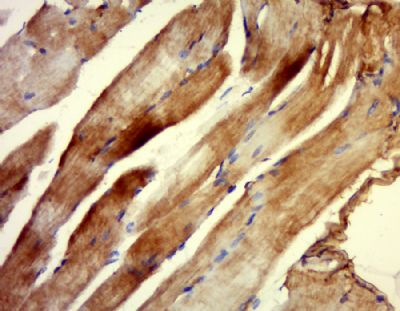产品货号 : mlR11734
英文名称 : NDUFS7
中文名称 : 线粒体复合物NDUFS7蛋白抗体
别 名 : CI 20; CI-20kD; Complex I 20kDa subunit; Complex I mitochondrial respiratory chain 20 KD subunit; Complex I-20kD; MGC120002; MY017; NADH coenzyme Q reductase; NADH dehydrogenase (ubiquinone) Fe S protein 7 20kDa (NADH coenzyme Q reductase); NADH dehydrogenase (ubiquinone) FeS protein 7, 20kDa (NADHcoenzyme Q reductase); NADH dehydrogenase (ubiquinone) FeS protein7, 20kDa (NADHcoenzyme Q reductase); NADH dehydrogenase [ubiquinone] iron-sulfur protein 7, mitochondrial; NADH-ubiquinone oxidoreductase 20 kDa subunit; NADH:ubiquinone oxidoreductase PSST subunit; NADHcoenzyme Q reductase; Ndufs7; NDUS7_HUMAN; PSST; PSST subunit.
研究领域 : 肿瘤 细胞生物 神经生物学 信号转导 新陈代谢
抗体来源 : Rabbit
克隆类型 : Polyclonal
交叉反应 : Human, Mouse, Rat, Chicken, Dog, Pig, Cow, Horse,
产品应用 : ELISA=1:500-1000
not yet tested in other applications.
optimal dilutions/concentrations should be determined by the end user.
分 子 量 : 20kDa
细胞定位 : 细胞浆
性 状 : Lyophilized or Liquid
浓 度 : 1mg/ml
免 疫 原 : KLH conjugated synthetic peptide derived from human NDUFS7:101-160/213
亚 型 : IgG
纯化方法 : affinity purified by Protein A
储 存 液 : 0.01M TBS(pH7.4) with 1% BSA, 0.03% Proclin300 and 50% Glycerol.
保存条件 : Store at -20 °C for one year. Avoid repeated freeze/thaw cycles. The lyophilized antibody is stable at room temperature for at least one month and for greater than a year when kept at -20°C. When reconstituted in sterile pH 7.4 0.01M PBS or diluent of antibody the antibody is stable for at least two weeks at 2-4 °C.
PubMed : PubMed
产品介绍 : Located in the mitochondrial inner membrane, mitochondrial complex I is the first and largest enzyme in the electron transport chain of oxidative phosphorylation. By oxidizing NADH that is produced in the Krebs cycle, this complex utilizes the two electrons to reduce ubiquinone to ubiquinol, thereby initiating the passage of electrons to successive complexes and ultimately leading to the reduction of oxygen to water. Mitochondrial complex I consists of over 40 subunits and is of considerable clinical interest since defects in any of the subunits can lead to various myopathies and neuropathies. As a subunit of mitochondrial complex I, NDUFS7 (NADH dehydrogenase [ubiquinone] iron-sulfur protein 7), also designated NADH-ubiquinone oxidoreductase 20 kDa subunit, is a 213 amino acid protein that is suggested to be required for catalytic activity. Defects in the gene encoding NDUFS7 are the cause of Leigh syndrome, a severe neurological disorder that is characterized by bilaterally symmetrical necrotic lesions in subcortical brain regions.
Function:
Core subunit of the mitochondrial membrane respiratory chain NADH dehydrogenase (Complex I) that is believed to belong to the minimal assembly required for catalysis. Complex I functions in the transfer of electrons from NADH to the respiratory chain. The immediate electron acceptor for the enzyme is believed to be ubiquinone.
Subunit:
Complex I is composed of 45 different subunits This is a component of the iron-sulfur (IP) fragment of the enzyme.
Subcellular Location:
Mitochondrion.
DISEASE:
Defects in NDUFS7 are a cause of Leigh syndrome (LS) [MIM:256000]. LS is a severe neurological disorder characterized by bilaterally symmetrical necrotic lesions in subcortical brain regions. Defects in NDUFS7 are a cause of mitochondrial complex I deficiency (MT-C1D) [MIM:252010]. A disorder of the mitochondrial respiratory chain that causes a wide range of clinical disorders, from lethal neonatal disease to adult-onset neurodegenerative disorders. Phenotypes include macrocephaly with progressive leukodystrophy, non-specific encephalopathy, cardiomyopathy, myopathy, liver disease, Leigh syndrome, Leber hereditary optic neuropathy, and some forms of Parkinson disease.
Similarity:
Belongs to the complex I 20 kDa subunit family.
SWISS:
O75251
Gene ID:
374291
Important Note:
This product as supplied is intended for research use only, not for use in human, therapeutic or diagnostic applications.
产品图片












